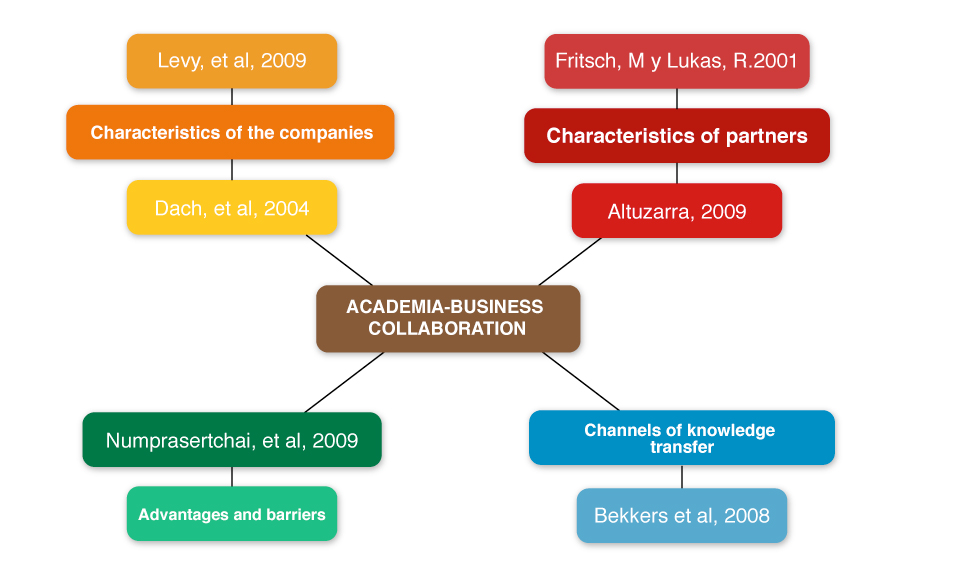The Interaction Between Academia and Business in Mexico
Posted By yelli On 26 October, 2016 @ 3:26 pm In Entrepreneurship,Edición 58 | No Comments
 By: Gabriela Maqueda,
By: Gabriela Maqueda,
Cinvestav
For several decades, innovation has been considered to be a key element of progress, industrial change and competiveness, and its determinants are carefully studied. In this context, the collaborative activities between companies and academia (universities, research institutes, etc.) are one of the most analyzed factors. The main interest in analyzing these collaborative activities lies in the fact that in order to concretize innovation projects companies need knowledge they generate internally or that they adopt from universities or research institutions (Tether, 2002).
The importance of the connection between academia and companies has been fully recognized and documented (for example, Suárez, 2013; De Fuentes and Dutrénit, 2012). The subject has been analyzed from the perspective of the companies and researchers, and it has been seen that collaboration has benefits for both groups, especially for three reasons: 1) a significant proportion of the high level innovations is the result of cooperation agreements (Tether, 2002); 2) the acquisition and assimilation of new knowledge is encouraged (van Rjinsoever, et al., 2008); and 3) the level of human and social capital of researchers increases (Boardman, 2009).
Since there are several reasons to encourage these collaborative activities between universities and businesses, for the past two decades numerous studies have been published that analyze factors such as the characteristics of different types of partners, the channels of knowledge transfer, the characteristics of the connected companies, as well as the advantages and barriers. Figure 1 shows the main factors of the analysis and the authors who have studied them are cited.

Figure 1. Factors of analysis in the collaborative activities between business and academia.
The Collaboration of Companies in Mexico
Every two years, INEGI conducts a survey on Research and Technological Development (ESIDET) for CONACYT. One of the main advantages of this survey is that it collects a large and representative national sample, since 3,124 companies were surveyed in 2006, 2,818 in 2008 and 4,118 in 2010.
The ESIDET has two units of analysis: the company (production sector) and the institution (sectors of higher education, government and non-profit institutions). In this study the company was considered as a unit of analysis and the three data sets corresponding to ESIDET 2006 (2004-2005), ESIDET 2008 (2006-2007) and ESIDET 2010 (2008-2009) were used, for which we have six years of information (2004-2009). In the databases, information was collected on the collaborative activities of academia and business and the data was analyzed with the Excel and Access programs.
Table 1 compares the participants that offer products or services and those that have created processes or methods. It is noted that despite the importance of the connection between the business and academia, companies carry out almost 70% of the innovation activities, without any type of collaboration.
Table 1. Development of products, services, processes and methods.
In general, it is shown that the collaboration between companies is considerably greater (between 12 and 17%) than between companies and research institutes, universities or other institutions of higher education, which is less than 10% in the three periods, for both product and process innovation.
Another important aspect that emerges from the table is that the data is uniform and varies little over time. For example, the percentage of the companies that collaborate with research institutes was less than 10% in 2006 and continued until 2010.
According to the data in Table 1, companies do not entrust the development of their innovation projects to universities or research institutes. That applies both to products or services as well as for processes or methods, since in both cases the percentage is virtually zero, which indicates that companies do not change their strategies of collaboration, since the figures are very similar in all three periods.
The Need for Collaboration
Thus, despite the proven importance of the collaborative activities between academia and business, the index of these activities is extremely low (about 5%, approximately) in Mexico.
Collaboration is important because factors such as the acquisition and assimilation of new knowledge and the increase in the level of human and social capital of researchers and entrepreneurs amply justify the promotion of these activities. It is also important that in Mexico activities recognized as determinants of innovation are encouraged, especially because a good system of innovation is essential for technological change, increased competitiveness and economic growth.
REFERENCES
Boardman, C. (2009), “Government centrality to university-industry interactions: University research centers and the industry involvement of academic researchers.” Research Policy, 38, 1505-1516.
De Fuentes and Dutrénit, G. (2012), “Best channels of academia-industry interaction for long-term benefit.” Research Policy 41:1666-1682.
Numprasertchai, S., Kanchanasanpetch, P., Numprasertchai, H. (2009), “Knowledge creation and innovation capability in the public university.” International Journal of Innovation and Learning 6, 568-580.
Suárez, D. (2013), “Dynamic innovative strategies at the firm level: The case of Argentinean manufacturing sector.” Document presented at the DRUID Academy 2013, in Comwell Rebild Bakker, Rebild, Aalborg, Denmark, 2013.
Tether, B. (2002), “Who co-operates for innovation, and why. An empirical analysis.” Research Policy 31, 947-967.
Article printed from Dirección Estratégica: http://direccionestrategica.itam.mx
URL to article: http://direccionestrategica.itam.mx/la-vinculacion-de-la-academia-y-la-empresa-en-mexico/
URLs in this post:
[1] Image: http://direccionestrategica.itam.mx/wp-content/uploads/2016/10/Tabla-1.jpg
